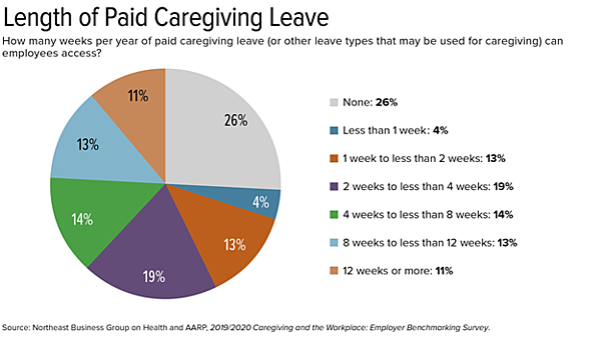
When we think of people most impacted by the COVID-19 pandemic, we first think of frontline workers and those who contracted the virus. But as time goes on, we see that there’s another group of people in this category: caretakers.
The pandemic has shed light on the role of the caretaker and the support they need on a regular basis, let alone during a health crisis. Employers should keep this in mind as they prepare to enter their 2021 Open Enrollment period, making caretaker consideration a top priority.
Unfortunately, caretaker-specific benefits have not been made a priority in the past by most organizations. This chart from the Society of Human Resource Management shows the current landscape of caregiver benefits:

It’s clear that even under normal circumstances caregiver benefits were not prioritized. Now adding a pandemic to the mix has only intensified the need for that to change. For some people who are caregivers, their new way of life includes juggling remote learning, working at home alongside other family members, making grocery and supply deliveries to older family members and dealing with very complex health situations.
The types of caregivers in your organizations
Understanding the types of caregivers you have in your organization can help you better understand their challenges, creating an opportunity to provide the right benefits.
- Elder caregivers. These individuals are caring for aging parents during a time where care facilities have visitation restrictions. It’s possible that one of your employees is now the sole caregiver to an elder parent because of COVID limitations. They are working to provide hands-on care in order to keep the older individual out of medical facilities where the exposure risk is greater, as well as limit exposure risks themselves since they need to provide care.
- Spousal caregivers. Similar to elder caregivers, some spouses of those with a long-term disability or chronic illness are now providing hands-on care in order to limit exposure and deal with facility closure.
- Parents. Parents are now tasked with supporting children through distance learning. This is especially challenging if the child is one of 7 million who receive special education support in school. These services are typically difficult to execute virtually, so parents are stepping in to fill the gap.
What benefits considerations employers can make for 2021
If you have employees that fall under this category, keep their needs in mind as you create your benefits offerings for the 2021 Open Enrollment period. Reach out to them and make an effort to understand the challenges they are facing. Often, they aren’t fully taking care of themselves because of their added responsibility for family members, so having someone concerned with their well-being will be appreciated.
That conversation can be the catalyst for selecting specific benefits to aid caregivers:
- Assistance securing home delivery of medication and groceries
- Telehealth to reduce trips to medical facilities
- Mental health benefits to deal with caregiver stress
- Subsidized activities to keep aging family members safe and engaged during isolation
- Dependent FSAs to ease the burden of caretaker expenses
- Subsidized child care
- Access to elder care services and information
- Family leave above and beyond FMLA
- Flexible schedules and work arrangements
- Reimbursement for self-care activities like exercise, massage, etc.
- Streamlined COVID-19 information and communication
If you are not sure where to start with gathering resources for caregivers, Caregiver.org is a great place to start.
Going into 2021, employers have the chance to make a difference for those who are making a difference for their loved ones. As the COVID-19 pandemic has shown us, caregivers need support and assistance now more than ever. The benefits selected for Open Enrollment can be the key differentiator that makes your caregiver employees feel less stressed, more engaged and overall more satisfied with their work-life balance.
Sources:
https://www.caregiver.org/coronavirus-covid-19-resources-and-articles-family-caregivers
https://www.nia.nih.gov/health/government-covid-19-resources-older-adults